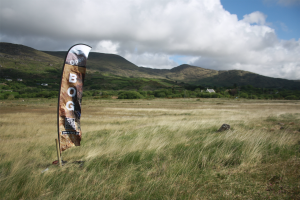 PRESS RELEASE
PRESS RELEASE
13th June 2016
Coad Bog BioBlitz provided chances for active learning and scientific discoveries
The species count for Coad Bog BioBlitz was 200 with 304 hours of observations from participants. The Blitz included hands on visits by all the children in Caherdaniel National School.
Participants combed the bog observing and recording as many plant and animal species as possible. Veteran BioBlitzer Ken Bond collected moths and other insects as part of the Blitz and even helped volunteers identify eggs of the Orange-tip Butterfly.
The BioBlitz put a spotlight on the value of science in Irish peatlands and offered a unique opportunity for the public to learn first-hand how important science is in managing peatlands for the future.
The Coad Bog Bioblitz that took place from the 20th-27th May in County Kerry was a wonderful success. The Irish Peatland Conservation Council (IPCC) gathered a large amount of essential information about the nature of the bog and the diversity of wildlife living on the site. This material will be an invaluable help in preparing a conservation plan for the bog later this year.
The top ten highlights of the BioBlitz included:
- Over 200 different species recorded on the site including birds, moths, butterflies, spiders, beetles, slugs, dragonflies, damselflies, mammals, flowering plants, mosses and liverworts.
- Rory Hodd a bryophyte expert recorded a massive 71 species of mosses and liverworts on the bog. One species called Anomolous Flapwort was a rare find for County Kerry; it has only been recorded once before in Kerry and is usually found in the raised bogs of the Irish midlands.
- The song of the Skylark could be heard and enjoyed by all during the week and some volunteers had the pleasure of observing a Meadow Pipit nest. The Pygmy Shrew Ireland’s smallest mammal was also recorded on the site. It consumes 1.25 times its body weight daily in beetles, spiders, bugs and woodlice to survive. This is due to its extremely small size and high metabolic rate.
- 13 different habitats were found on the 10 acre site. These included wet bog, grassland, rocky outcrop, bog ditch and stream. The most diverse of these habitats was a stream that contained 22 different species of plant. Other rich habitats on the site included; the Molina grassland habitat and the Sphagnum rich typical blanket bog habitat in the centre of the bog, each of which contained 15 species.
- The deepest peat recorded in the bog was 4 m. A peat core showed that Coad Bog formed directly on rocky soil with Old Red Sandstone boulders. It is likely that parts of the bog may be up to 7,000 years old.
- Some 4,000 year old pine stumps were spotted throughout the bog. The stumps were exposed in the 19th century during turf cutting. Some of these pine stumps appeared black in colour due burning of the bog in the past.
- The water levels recorded on the bog ranged from 1.5cm to 75 cm below the surface. These readings reflect the different habitats found on the bog with the lower readings being recorded in the central area of the bog which was the typical swampy blanket bog habitat and the higher readings being recorded in the drier habitats around the edge of the bog and near rocky outcrops.
- The pH on the site ranged from 5.1 recorded in a bog pool to 6.8 recorded in the stream.
- The students from Caherdaniel National School enjoyed an educational visit on Coad Bog. The children explored methods of recording wildlife on the bog. They also learnt how to measure peat depth and water levels allowing them to become junior wildlife rangers. All of the children and teachers enjoyed their visit and discovered the beauty and value of blanket bog habitats. Over 100 people visited the bog during the BioBlitz event. This included 28 volunteers and 32 people from the local community who attended a Night Safari on the site.
- A total of 304 volunteer hours were contributed to the BioBlitz from 28 different volunteers taking part in wildlife surveys and conservation management throughout activities. Volunteers from Kerry were joined by others from Dublin, Kildare and Cork.
The IPCC would like to take this opportunity to say a huge thank you to all who took part in the Coad Bog BioBlitz. ‘It was a fantastic week full of exciting discoveries. It was brilliant to meet with the local people and hear about the history of the area. The local people were so friendly and supportive, we couldn’t have asked for a better welcome to County Kerry’ says Katie Geraghty, IPCC’s Campaign Officer.
The BioBlitz event was made possible through sponsorship by the Environmental Protection Agency under their EPA Research Programme 2014-2020 and supported by the Irish Environmental Network under their Biodiversity Events Funding 2016 and the IPCC’s Friends of the Bog.
If you would like further information about Coad Bog and the results of the BioBlitz contact Katie at bogs@ipcc.ie or call 045 860133.
